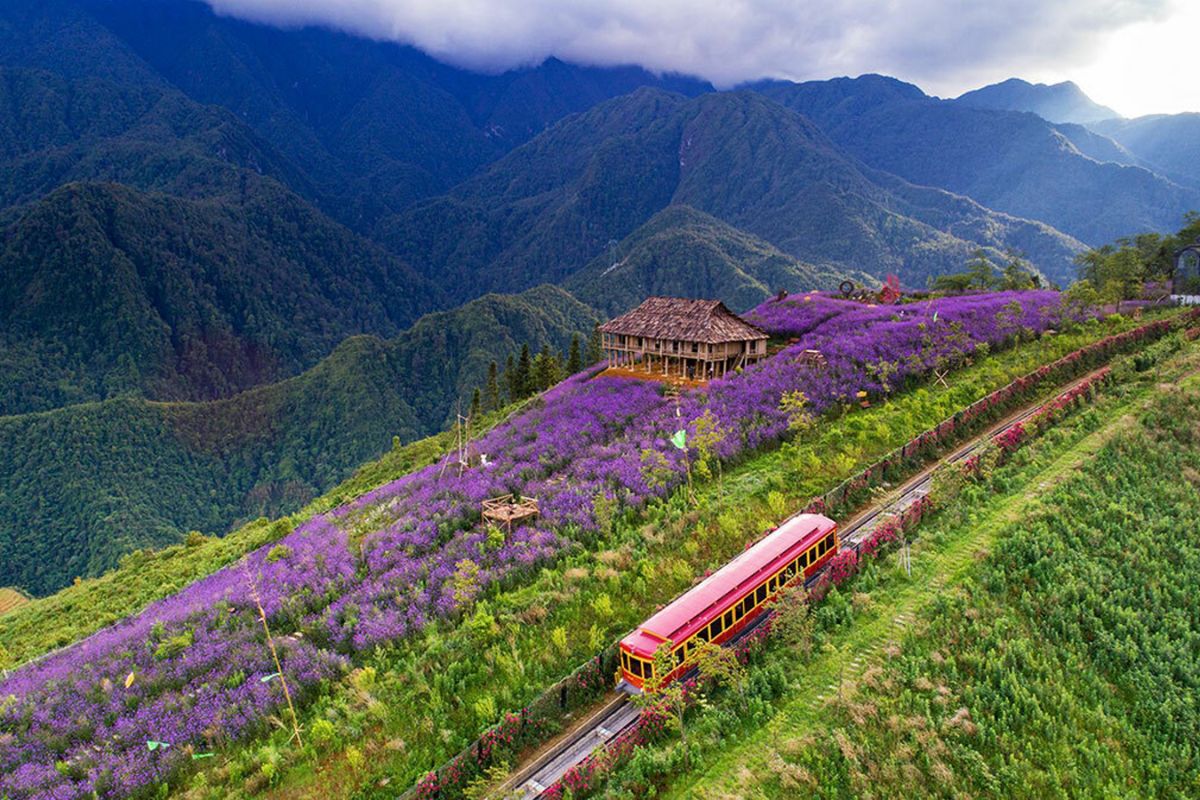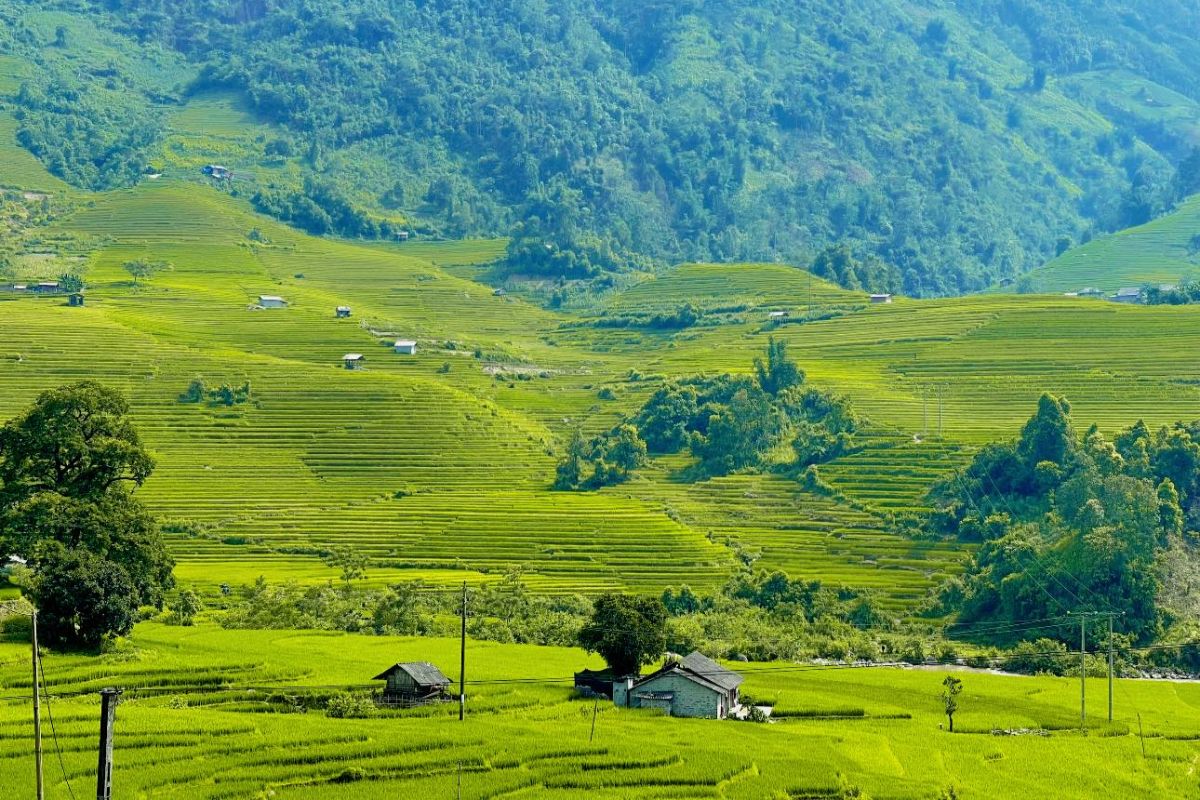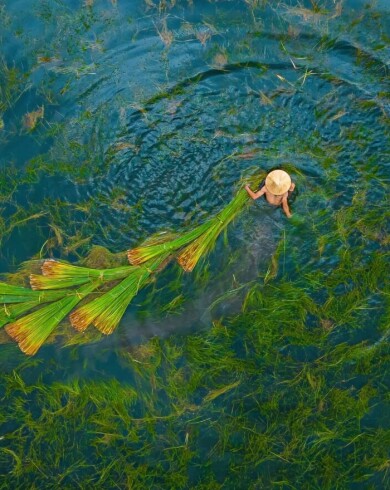TABLE OF CONTENT
Sapa Vietnam is always an attractive destination because of the rustic and majestic beauty that nature has bestowed upon this place. Among the places worth visiting in Sapa, Sapa Valley Vietnam cannot be missed, the valleys have poetic beauty and are no less culturally diverse because of the ethnic community here. So what are you waiting for in the famous valleys in Sapa, explore with Asia Encounter in the article below.

Where is Sapa Vietnam?
Nestled in Lao Cai Province in northern Vietnam, Sapa is a serene mountain town close to the border with China. It lies approximately 320 kilometers northwest of Hanoi, making it easily accessible by overnight trains or sleeper buses. The Hoang Lien Son mountain range, sometimes referred to as the “Alps of Indochina”, is famously accessible from Sapa. Hikers and environmentalists are drawn to the area by Fansipan, Vietnam’s highest peak.
Due to its geographical location, Sapa Vietnam is home to many ethnic groups, such as the Hmong, Dao, Tay, and Giay, and is also a hub of natural beauty. The colorful markets, vibrant customs, and friendly people add to the appeal of the area. Sapa is a great place to explore and relax, offering a great combination of breathtaking scenery and cultural immersion.
What makes Sapa Valley Vietnam special?
Sapa Valley Vietnam is a living canvas that showcases the remarkable diversity of Vietnam’s natural and cultural history, it is more than just a tourist destination. Several remarkable features combine to create an unparalleled travel experience that truly makes this region unique.
The incredible diversity of landscapes: With steep terraced rice fields, dense forests, tumbling waterfalls and rocky peaks that seem to reach for the sky, the valley offers a stunning natural picture. Throughout the year, these landscapes offer exceptional visual experiences as they undergo dramatic seasonal changes.
Rich ethnic diversity: Home to multiple ethnic minority groups including Hmong, Red Dao, Tay, and Giay communities, Sapa Valley Vietnam represents a vibrant mosaic of traditional cultures. The social behavior, dress, dialect, and customs of each tribe have remained largely unchanged over time.

Agricultural Wonder: Sapa’s legendary rice terraces are considered one of the most exquisite agricultural landscapes in the world. These elaborately constructed terraces represent incredible agricultural innovation and human adaptability as they were carved into steep mountain slopes over millennia.
Sustainable Tourism Model: Sapa has created a community-based tourism strategy that directly benefits local ethnic groups, unlike many other tourist attractions. While boosting the region’s economic growth, Sapa tourists can engage in authentic cultural experiences.
3 best Sapa valleys to visit
Muong Hoa Valley
Muong Hoa Valley is a quintessential destination for those seeking the heart of Sapa’s beauty and culture. Muong Hoa Valley stretches over 15km, including many ethnic villages such as Lao Chai, Ta Van and Y Linh Ho. Visiting each village is a different opportunity to learn about the rich culture and life of ethnic minorities in Vietnam, through traditional stilt houses, vibrant festivals, traditional crafts,…

Sweeping views of terraced rice fields cascading down the mountainside are a reward for Sapa tourists to Muong Hoa Valley. The immersive experience of walking through these fields allows visitors to observe the indigenous way of life up close. During harvest season, the golden hues of the fields create a breathtaking scene and are truly remarkable. Living among the Hmong and Giay communities in the valley through homestays offers the opportunity to develop closer cultural bonds through the exchange of meals and stories that enhance the experience.
Ta Van Valley
Ta Van Valley is a quiet retreat from the bustling areas of Sapa town attractions, part of the larger Muong Hoa region. The Giay people, known for their characteristic stilt houses and kind demeanor, are the main inhabitants of this valley. The river that runs through the valley, surrounded by lush green mountains, adds to the peaceful appeal of this place.

Hiking or cycling in Ta Van Valley is a great way to experience the tranquil atmosphere of this place. Sapa visitors can participate in cultural exchanges with the Giay community, such as learning traditional cooking techniques or joining in their vibrant festivals. Unlike the more crowded areas of Sapa, Ta Van provides an intimate experience, allowing travelers to truly connect with the landscape and its people. The valley’s unspoiled beauty and slower pace of life make it a perfect destination for those seeking relaxation and authenticity.
Ban Ho Valley
Ban Ho Valley is a hidden gem that offers an unusual experience. It is located about 25 km from Sapa town. The ancient wooden stilt houses of the Tay people who live in this valley blend perfectly with the natural surroundings. Surrounded by dense forests, the valley is famous for its natural hot springs and the spectacular Silver Waterfall.
With trails leading to remote waterfalls and sweeping views, a walk through Ban Ho Valley will reveal its unspoiled beauty. A haven for recreation, visitors can relax in the hot springs or take a dip in the cool natural pools. Ban Ho is less crowded than the more popular valleys, allowing for a more private and peaceful experience. Ban Ho Valley is a great choice for those seeking peace and adventure.

When to visit Sapa Vietnam?
The best time to visit Sapa depends on what you wish to experience.
- Spring (March-May): March to May is the best time of year to see the spectacular rice planting season. Water floods the terraced fields, creating beautiful reflections that make for stunning photos.
- Summer (June–August): The busiest tourist season, with lush green landscapes. The mild temperatures make hiking and other outdoor activities pleasant.
- Autumn (September-November): The best season is arguably autumn when the golden terraced fields are ready for harvest. Photographers will find this period enchanting.
- Winter (December-February): In the higher elevations, there may be snowfall during the winter. Cold weather, and sometimes snow, transforms Sapa into a winter wonderland.
FAQs
How to get to Sapa Valley Vietnam?
Most of the valleys can be reached by foot, motorbike or private car. There are also hassle-free guided tours.
Are the valleys suitable for families with kids?
Yes, some valleys, such as Ta Van and Muong Hoa, offer family-friendly activities such as homestays and cultural workshops in addition to convenient hiking routes.
Is it possible to visit all three valleys in one trip?
While it’s possible, it’s best to focus on one or two valleys to fully appreciate their beauty and cultural offerings.
What to wear to visit Sapa Valley Vietnam?
Wear a raincoat, layers of clothing and comfortable walking shoes. Don’t forget to use sunscreen and insect repellent.
Are there food options in the valleys?
Yes, local villages often have small restaurants or homestays where you can enjoy traditional Vietnamese meals.
Sapa Valley Vietnam offers an unrivaled combination of adventure, cultural diversity, and scenic beauty. Each valley has something special to offer, whether it’s the famous rice terraces of Muong Hoa, the peaceful retreat of Ta Va,n or the pristine landscapes of Ban Ho.
—
Make your journey seamless by booking with Asia Encounter, a travel agency specializing in Vietnam’s hidden gems. From expertly guided treks to curated cultural experiences, Asia Encounter ensures you’ll uncover the true essence of Sapa. Let us help you craft the adventure of a lifetime!




